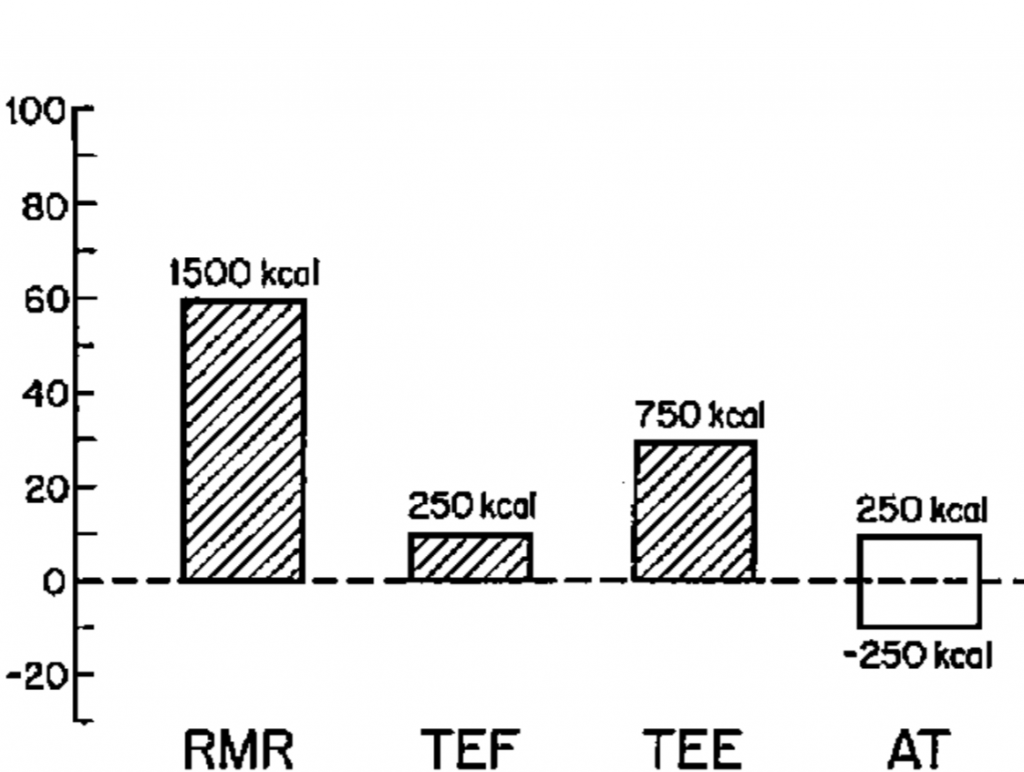The Minnesota experiment was a famous nutritional study published by Ancel Keys and other in the 1950’s. The study investigated the effects of starvation g on healthy subjects. This study involved a 12 week control phase where baseline characteristics were observed and recorded, followed by a 12 week starvation phase and then a recovery phase where refeeding and medical monitoring of detrimental health effects occurred in a controlled (12 week) and a free living (8 week) phase. The starvation caused each subject to lose an average of 25 % of their body weight which was made up of both lean tissue and body fat. The experiment was seminal because it highlighted the detrimental effects of even modest long term energy restriction. Despite obtaining 1560 kcal per day, the subjects in the experiment experienced significant physiological and mental decline. These included periods of hysteria, depression and an unhealthy obsession with food. Basal metabolic rate was significantly reduced and this was reflected in reductions in heart rate, respiratory rate and temperature.
Since this time a number of experiments have attempted to replicate the findings of the original Minnesota experiment, albeit with shorter timescales. For example a recent study investigated the effects of very low energy intakes on a number of healthy subjects. Subjects were overfed for 1 week at an energy level that increased energy intake by 50 %. Energy restriction at 50 % less than maintenance levels was then followed by the subjects for three weeks. Finally the subjects had a two week refeeding period of energy that was 50 % over maintenance energy needs. The results of the study showed that the energy restriction caused the subjects to lose more lean tissue (159 grams per day) than fat (114 grams per day). In other words, over half of the weight lost by the subject was lean tissue vital to health. Of the fat free mass lost, there was a 5 % decrease in skeletal muscle tissue, a 13 % decrease in liver tissue and an 8 % reduction in kidney tissue. This loss of lean tissue has been reported in many subsequent studies since the Minnesota experiment.

Adaptive thermogenesis is the component of energy expenditure that is accounted for by changes to the efficiency of energy metabolism. These changes in efficiency appear to be independent of hormonal changes. As energy intake increases, energy wastage increases. As energy intake falls, energy wastage is limited and efficiency improves. This allows a set body weight to be maintained despite changes in energy intake and physical activity.
The reduction in lean tissue seen during the starvation phase lead to a significant decrease in resting metabolic rate that equated to 266 kcal per day. This was accompanied by a 15 % reduction in respiratory quotient, indicating that there was a shift from carbohydrate to fat oxidation in the metabolism of the individuals. Further the reduction in resting metabolic rate was accompanied by a reduction in blood pressure of 7 % and a reduction in heart rate of 14 %. Other aspects of energy metabolism also become more efficient with the cost of walking falling by 22 %, and a fall in sympathetic nervous system activity of 38 %. These changes confirm that reducing energy intake also increases the efficiency of the individual making weight loss a less likely event as time proceeds. That vital organ weight and skeletal muscle mass is reduced with starvation shows that very low energy diets are not conductive to good health and should be avoided if long term health is a priority.
Hormonally, testosterone (in the all male subjects) fell by 11 %. This was accompanied by a 44 % reduction in leptin, a 54 % reduction in insulin, a 49 % reduction in adiponectin and a 39 % reduction in triiodothyronine. Therefore hormonal activity was significantly affected, with the changes indicating that a shift in energy metabolism had occurred towards one of catabolism and energy conservation. It has been estimated more recently that adaptive thermogenesis, the adaption to changes in energy intake through increases in efficiency of metabolism, accounted for around 72 kcal per day of the reduction in resting metabolic rate. Further, changes in leptin, insulin, ghrelin and thyroid hormones were independent of this adaptive thermogenesis component. Therefore the efficiency of energy production by a reduction in overall energy wastage is a measurable phenomenon that has been understood since the 1950’s (at least). Weight loss is therefore far more complex and multifaceted than a simple reduction in energy intake.
Eat Well, Stay Healthy, Protect Yourself
RdB

